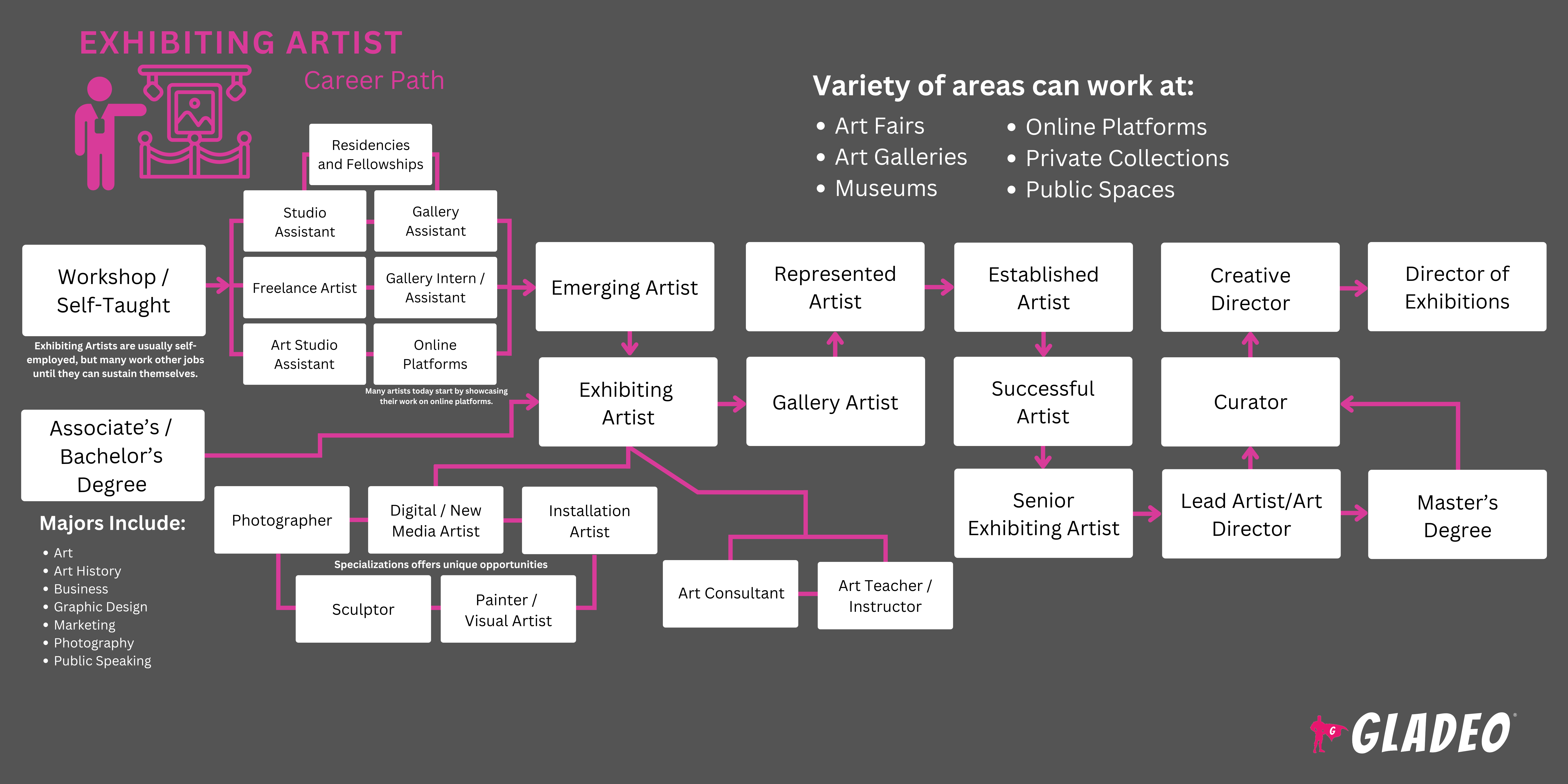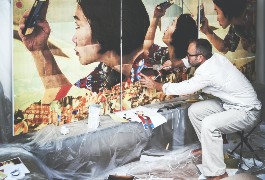Focos de atención
Artista, Artista ceramista, Diseñador, Artista de fibra, Artista de artesanía fina, Fabricante de muebles, Artista del vidrio, Soplador de vidrio, Orfebre, Tejedor a mano, Artista de exposiciones, Artista visual, Artista de galería, Artista de estudio, Artista fino, Artista contemporáneo
Los artistas expositores son profesionales creativos que producen obras de arte originales y las exponen en lugares públicos o privados, como galerías, museos y ferias de arte.
Sus creaciones pueden ir desde pinturas y fotografías hasta esculturas o instalaciones de técnica mixta. Su principal objetivo, aparte de vender sus obras para ganar dinero, es comunicar ideas y captar la atención de los espectadores. A través de su obra, exploran conceptos estéticos, ofrecen comentarios visuales sobre temas y contribuyen al paisaje cultural.
A diferencia de la mayoría de las demás carreras, esta profesión no es sencilla ni predecible. Requiere talento creativo, perseverancia y una sólida comprensión de los aspectos comerciales del mundo del arte, como el marketing, las ventas y la creación de redes con galerías, comisarios y coleccionistas.
Los artistas expositores pueden dedicar meses a crear obras sin garantías de que se expongan o vendan. Deben encontrar galerías adecuadas dispuestas a organizar exposiciones, y a veces las galerías cobran un alquiler por el espacio (junto con una comisión por las piezas vendidas).
Una vez conseguido un espacio de exposición, los artistas deben preparar y transportar sus obras a la galería donde se expondrán. A menudo participan en recepciones inaugurales en las que hablan con el público, los posibles compradores y los críticos de arte presentes. En definitiva, puede ser un campo gratificante, pero también hay mucha incertidumbre y la posibilidad de que surjan problemas económicos mientras los artistas se esfuerzan por aumentar su reputación.
- Expresar la creatividad y la visión personal a través del arte
- Interactuar con el público y recibir comentarios
- Que su trabajo sea apreciado y valorado en las exposiciones
- Oportunidades para viajar y conocer diferentes escenas artísticas
Horario de trabajo
Los artistas expositores suelen trabajar de forma independiente en casa o en estudios. Suelen fijar sus propios horarios y pueden tener intensos periodos de trabajo previos a las exposiciones. Es necesario viajar para transportar sus obras y asistir a las exposiciones.
Tareas típicas
- Desarrollar ideas creativas para hacer arte original
- Crear bocetos, plantillas o modelos a partir de los cuales trabajar
- Establecer un presupuesto para la compra de suministros
- Seleccionar los materiales que se van a utilizar en función del color, la textura, la durabilidad y otros factores.
- Desarrollar piezas artísticas en diversos medios (por ejemplo, pintura, escultura, fotografía, etc.). Dar forma, unir o cortar materiales según sea necesario.
- Generar cuerpos de trabajo cohesionados para exposiciones. Preparar documentación como descripciones, comunicados de prensa, invitaciones y material promocional.
- Haz fotos durante el proceso de creación y una vez terminadas las piezas
- Desarrollar portafolios para mostrar las piezas a galerías y coleccionistas.
- Colaborar con galerías y comisarios para organizar y planificar exposiciones, incluidas muestras colectivas o temáticas, si procede.
- Gestionar la logística, como el enmarcado, el transporte y la instalación de las obras de arte.
- Obtener un seguro especializado en arte, si es necesario
- Exponer obras en galerías, subastas, ferias, museos, publicaciones impresas y mercados en línea.
- Mantener una presencia en línea a través de sitios web y redes sociales
- Interactuar con el público y los compradores potenciales, especialmente en las inauguraciones de exposiciones.
Responsabilidades adicionales
- Manténgase al día de las tendencias artísticas
- Participar en residencias artísticas y talleres
- Solicitar subvenciones y financiación
- Establezca contactos con otros artistas, coleccionistas y profesionales del arte
- Gestionar los aspectos empresariales aplicables, como marketing, ventas, redes, contabilidad, pago de impuestos, etc.
- Tenga en cuenta que hay muchas consideraciones fiscales a tener en cuenta, entre otras:
- Gastos contables y jurídicos
- Gastos de publicidad y promoción
- Tasas empresariales asociadas
- Comisiones pagadas a las galerías
- Impuestos sobre las ventas
- Seguro (incluido el de automóvil, ya que los artistas deben transportar sus obras)
- Gastos de alquiler de estudios y galerías
- Suministros, materiales y equipos
- Gastos de viaje
Habilidades blandas
- Habilidades de comunicación
- Creatividad
- Orientación al cliente
- Disciplina
- Buena visión de los colores
- Independencia
- Motivación
- Negociación
- Conexión a la red
- Personalidad extrovertida
- Paciencia
- Persistencia
- Persuasión
- Resiliencia
- Vendedor
- Gestión del tiempo
Habilidades técnicas
Los conocimientos técnicos necesarios dependen del medio que prefiera el artista. Por ejemplo:
- En pintura, los artistas expositores pueden trabajar con óleos, acrílicos, acuarelas, témperas o encáustica, utilizando herramientas como pinceles, espátulas, lienzos, caballetes, paletas, esponjas, disolvente y yeso.
- Para la escultura, los artistas pueden utilizar arcilla, piedra, metal, madera, yeso o resina, empleando cinceles, martillos, mazos, herramientas de modelado, hornos, equipos de soldadura, sierras, herramientas de talla, papel de lija, limas, moldes y herramientas de fundición.
- En fotografía, los artistas utilizan cámaras, objetivos, trípodes, equipos de iluminación, cámaras oscuras (para película), programas de edición como Photoshop y Lightroom, impresoras y material para enmarcar y colocar en bastidores.
- El grabado abarca el aguafuerte, la litografía, la serigrafía, la xilografía y el linograbado, con herramientas como prensas de impresión, rasquetas, planchas de entintado, herramientas de tallado, pantallas, rasquetas, agujas de grabado, baños ácidos, piedras litográficas, rodillos, papel y tinta.
- Para el arte de técnica mixta, los artistas utilizan adhesivos, tijeras, cuchillas X-Acto, agujas de coser, hilo, alfombrillas de corte, pinturas, rotuladores, pinceles, esponjas, papel de lija y limas.
- El arte digital se crea con tabletas gráficas, lápices ópticos, ordenadores, monitores, programas como Photoshop, Illustrator, Blender y Maya, impresoras 3D (para modelos físicos), dispositivos de almacenamiento e impresoras.
- El arte textil (tejer, tricotar, bordar, acolchar) requiere telares, agujas de tricotar, ganchillos, aros de bordar, agujas, máquinas de coser, tijeras, tijeras para tejidos, hilos, lanas, telas, cintas métricas y reglas.
- En el arte del vidrio, ya sea coloreado, soplado, fundido o lampwork, los artistas utilizan cortadores de vidrio, hornos, sopletes, soldadores, amoladoras de vidrio, moldes y guantes y gafas de protección.
- La cerámica implica trabajar con loza, gres, porcelana o rakú utilizando ruedas de alfarero, hornos, extrusoras de arcilla, herramientas de modelado, engobes, esmaltes, pinceles para aplicar el esmalte y cortaalambres.
- El trabajo con metales, como la joyería, la herrería, la escultura en metal o el esmaltado, requiere yunques, martillos, sopletes, soldadores, cortadoras de metal, cizallas, limas, lijadoras, moldes de fundición y ruedas de pulir.
Otras competencias técnicas más generalizadas son
- Capacidad para comisariar e instalar exposiciones
- Firmeza de brazos y manos
- Perspicacia comercial y aptitudes de marketing
- Competencias digitales para marketing y ventas en línea
- Diseño gráfico
- Conocimientos de historia del arte y arte contemporáneo
- Destreza manual
- Creación de carteras
- Redacción de comunicados de prensa
- Ferias de arte
- Galerías de arte
- Instituciones culturales
- Estudios independientes
- Revistas
- Museos
- Plataformas en línea
Se espera de los artistas expositores que creen obras de alta calidad que encarnen su visión única y resuenen en el mercado del arte, que puede ser notoriamente impredecible.
Deben compaginar su actividad creativa con exigencias prácticas, como exponer y vender sus obras constantemente. Ganarse una reputación suele llevar años y, aun así, el valor de las obras puede fluctuar con las tendencias del mercado. Esto puede convertirse en una experiencia estresante.
Debido a las incertidumbres financieras inherentes al mundo del arte, muchos artistas expositores complementan sus ingresos con otros trabajos. Es posible que tengan que luchar contra el rechazo y las críticas de críticos y galeristas, cuyas opiniones pueden afectar a sus carreras y medios de vida. Pero los artistas con más éxito no se rinden, siguen desarrollando su talento, se adaptan y aprenden de los errores, y se mantienen fieles a su visión y sus objetivos.
El mundo del arte está experimentando cambios significativos, con varias tendencias clave que configuran su futuro. Uno de los cambios más destacados es la adopción de la transformación digital, en la que los artistas exponen cada vez más sus obras en línea y aprovechan las redes sociales para conectar con un público más amplio y global. Las exposiciones virtuales y las plataformas de venta en línea se están convirtiendo en habituales y ofrecen nuevas vías de visibilidad, ingresos y colaboración.
Mientras tanto, las experiencias artísticas inmersivas, como las instalaciones interactivas y el arte de realidad aumentada, también están ganando popularidad. El auge de los NFT (Non-Fungible Tokens) ha abierto nuevas e interesantes posibilidades para la propiedad y monetización del arte digital, aunque conlleva cierto riesgo, ya que los valores pueden caer rápidamente.
La sostenibilidad es una prioridad creciente, y cada vez más artistas recurren a materiales ecológicos. También se presta mucha más atención a las prácticas inclusivas, lo que genera más oportunidades para artistas de comunidades infrarrepresentadas.
Los artistas que exponen suelen tener una pasión de toda la vida por la creatividad y la expresión visual. Puede que de niños les gustara dibujar, pintar o construir cosas. Es probable que muchos participaran en clases o clubes de arte.
- No hay requisitos educativos obligatorios para los Artistas Expositores, pero muchos tienen una licenciatura en Bellas Artes o un campo relacionado.
- La educación formal proporciona destrezas técnicas, conocimientos de historia del arte y oportunidades para crear un portafolio.
- Los requisitos de los cursos varían en función del medio que utilice el artista. Los cursos más comunes son:
- Historia del Arte
- Teoría y crítica del arte
- Negocios para artistas
- Cerámica
- Teoría del color
- Prácticas artísticas contemporáneas
- Medios digitales
- Dibujo y pintura
- Dibujo de figuras
- Diseño gráfico
- Instalación artística
- Marketing para profesionales creativos
- Fotografía
- Desarrollo de la cartera
- Arte textil
- Comunicación visual
- Además, los artistas deberían considerar la posibilidad de seguir cursos de negocios y marketing para gestionar los aspectos comerciales de su carrera artística.
- Las certificaciones opcionales y el aprendizaje continuo también son importantes. Los artistas pueden beneficiarse de participar en residencias artísticas y talleres para perfeccionar sus técnicas y mantenerse al día de las nuevas tendencias y herramientas.
- Puede resultar difícil evaluar el valor de los programas educativos de arte. Muchos estudiantes buscan programas afiliados a la Asociación Nacional de Escuelas de Arte y Diseño, que cuenta con cientos de instituciones acreditadas como miembros de su organización. Entre ellas hay escuelas de arte, conservatorios, facultades y universidades.
- Los programas deben ofrecer un profesorado experimentado, estudios bien equipados y oportunidades de exposiciones y prácticas.
- También son beneficiosas las oportunidades de establecer contactos y la exposición a artistas visitantes y profesionales del arte.
- Considere el coste de la matrícula, los descuentos y las oportunidades de becas locales (además de la ayuda federal).
- Piense en su horario y flexibilidad a la hora de decidir si se matricula en un programa presencial, en línea o híbrido. Lo ideal es que practiques todo lo que puedas.
- Revise los detalles sobre la red de antiguos alumnos del programa y el éxito que han tenido en sus carreras.
- Tomar cursos de arte, diseño gráfico, historia del arte, fotografía, oratoria y negocios.
- Únete a clubes de arte en la escuela o en la comunidad local. Si no hay ninguno, ¡crea el tuyo propio!
- Voluntariado en proyectos de arte público
- Intenta vender tus obras en eventos locales o en Internet. Considera la posibilidad de hacer grabados o vender otros productos que incluyan imágenes de tu arte, si procede.
- Crea una cartera de trabajos para compartir en tu sitio web y en las redes sociales.
- Piensa en tu marca personal y en cómo quieres que te perciban como artista.
- Habla con los comercios locales sobre la posibilidad de exponer tus obras para darlas a conocer
- Estudiar libros, artículos y tutoriales en vídeo relacionados con el medio artístico elegido.
- Lee sobre artistas de éxito para inspirarte y comprender mejor.
- Solicita puestos de aprendizaje o busca un mentor que pueda guiarte
- Asistir a exposiciones de arte y relacionarse con la comunidad artística local
- Manténgase informado sobre las tendencias y técnicas del arte contemporáneo

- Los artistas expositores suelen ser autónomos, pero muchos tienen otros trabajos hasta que pueden mantenerse por sí mismos.
- Utiliza portales de empleo como Indeed para encontrar oportunidades de trabajo relacionadas con el arte
- Preparar una cartera sólida, un currículum y una declaración artística para destacar sus habilidades y experiencia.
- Utiliza los servicios profesionales de tu centro de estudios para obtener ayuda en la búsqueda de empleo, la redacción de currículos y las entrevistas.
- Pregunta en tu programa si tienen contactos en la industria que puedan ayudarte.
- Participe en eventos relacionados con el arte en los que pueda mostrar su obra y aumentar su reputación.
- Participa en concursos de arte, promociónate en las redes sociales y consigue audiencia en sitios web de arte populares como DeviantArt.
- Considere la posibilidad de crear un portafolio impreso con copias de alta calidad de su trabajo. Llévelo a los eventos, junto con tarjetas de visita o material promocional.
- Trasladarse a zonas con una vibrante comunidad artística y muchas galerías.
- Investigue las galerías adecuadas. Intente visitarlas o revise detenidamente sus sitios web o publicaciones. Infórmate sobre sus normas de presentación y envía una carta de solicitud profesional, si es necesario.
- Participar en foros en línea para obtener asesoramiento
- Pregunta a tus profesores, supervisores y compañeros si pueden servirte de referencia personal.
- Establezca contactos con otros artistas y profesionales del arte
- Ofrecer constantemente obras de arte innovadoras, creativas y de alta calidad que atraigan a los compradores.
- Establezca contactos con marchantes y asesores de arte para promocionar su obra entre clientes de alto nivel y prestigiosas galerías.
- Forjar relaciones sólidas con el personal de la galería, los conservadores, los coleccionistas y otros compradores.
- Diversifique sus técnicas experimentando con diferentes medios, estilos y enfoques.
- Desarrollar una obra coherente que defina su estilo y haga que su arte sea reconocible.
- Centrarse en crear una marca personal sólida que comunique su visión artística, sus valores y su identidad a coleccionistas y galerías.
- Aproveche las redes sociales y las plataformas digitales para compartir su trabajo, su proceso y sus exposiciones.
- Siga desarrollando su presencia en Internet para comercializar directamente su trabajo
- Incluya otros productos como láminas, ropa u otros artículos con sus diseños o imágenes.
- Colaborar con otros artistas, diseñadores o creativos en proyectos de promoción cruzada y llegar a nuevos públicos.
- Solicite encargos de arte público para aumentar su visibilidad y consolidar su reputación.
- Ofrezca talleres o clases para compartir sus conocimientos y forjarse una reputación de experto.
- Documente y comparta su trayectoria artística a través de blogs, vlogs o boletines informativos para establecer una conexión más profunda con su público.
- Conseguir un mentor que pueda proporcionar orientación, comentarios y conocimientos sobre el sector.
- Vea y aprenda de los artistas más veteranos
- Afiliarse a organizaciones profesionales e intentar ganar premios u otros reconocimientos.
- Solicitar subvenciones del Fondo Nacional de las Artes u otras organizaciones
- Buscar formación adicional y residencias para perfeccionar las habilidades, aprender cosas nuevas y conocer a otros artistas.
- Participe en eventos, ferias de arte y exposiciones internacionales. Presta atención a las tendencias al tiempo que intentas expresar tu estilo único.
Páginas web
- Consejo Americano de Artesanía
- Artforum
- Asociación de Artistas Herreros de Norteamérica
- ArtNet
- Artsy
- Sociedad de Arte en Vidrio
- Asamblea Nacional de Agencias Artísticas Estatales
- Asociación Nacional de Artistas Independientes
- Asociación Nacional de Escuelas de Arte y Diseño
- Fondo Nacional de las Artes
- Sociedad Nacional de Escultura
- Sociedad Nacional de Acuarela
- Fundación de las Artes de Nueva York
- Pintores al óleo de América
- Arte Saatchi
- Gremio de escultores
- Sociedad de Pintores Decorativos
- Sociedad de Ilustradores
- El Periódico del Arte
Libros
- ARTE/TRABAJO: Everything You Need to Know (and Do) As You Pursue Your Art Career, de Heather Darcy Bhandari y Jonathan Melber.
- Arte Dinero Éxito: Por Fin Gana Dinero Haciendo Lo Que Te Gusta: A Complete and Easy-to-Follow System for the Artist Who Wasn't Born with a Business Mind, por Maria Brophy
- Cómo vender arte: A Systematic Approach to Creating Relationships with Collectors and Closing the Sale, por J. Jason Horejs
- Cómo vender tu arte online: Live a Successful Creative Life on Your Own Terms, por Cory Huff
- La guía del artista: Cómo ganarse la vida haciendo lo que te gusta, de Jackie Battenfield
Trabajar como artista expositor puede ser una carrera estimulante pero impredecible. Si buscas algo con una vida laboral más estable, considera algunas de las opciones relacionadas a continuación:
- Animador
- Ilustrador arquitectónico
- Profesor de arte
- Ilustradora de libros infantiles
- Artista del cómic
- Dibujante de Tribunales
- Editor de escritorio
- Dibujante
- Diseñador de moda
- Director de Galería
- Diseñador gráfico
- Ilustrador
- Diseñador industrial
- Ilustrador médico
- Trabajador del museo
- Escenógrafo
- Artista de efectos especiales
- Artista de guiones gráficos
- Artista del tatuaje
- Ilustrador técnico
- Ebanista
Newsfeed

Trabajos destacados

Cursos y herramientas en línea

Expectativas salariales anuales
Los nuevos trabajadores empiezan en torno a los 66.000 dólares. El salario medio es de 79.000 dólares al año. Los trabajadores con más experiencia pueden ganar unos 85.000 dólares.






